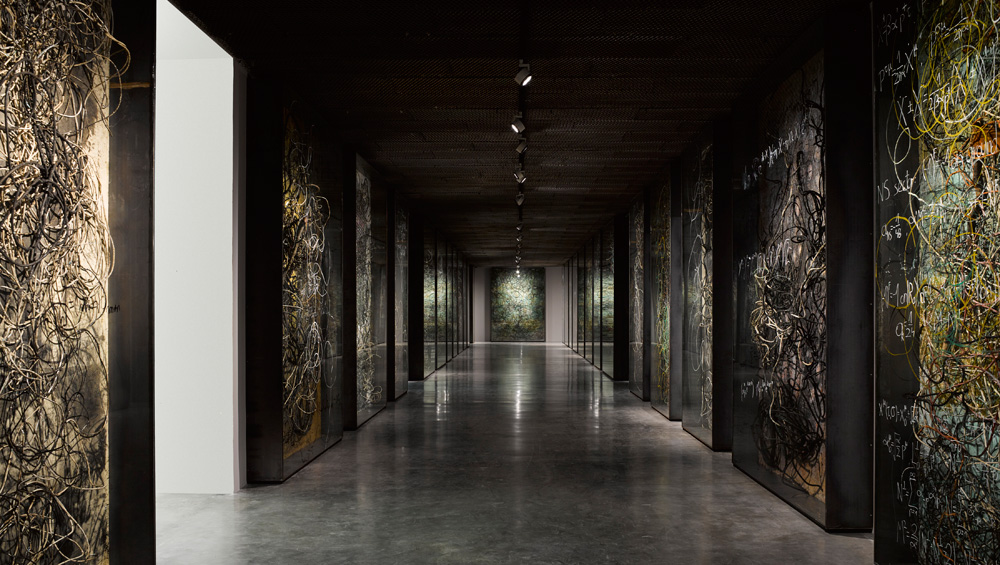
Anselm Kiefer, Superstrings, Runes, The Norns, Gordian Knot, White Cube Bermondsey, 2019. © Anselm Kiefer. Photo © White Cube (Ollie Hammick). Courtesy White Cube.
White Cube Bermondsey, London
15 November 2019 – 26 January 2020
by BETH WILLIAMSON
This exhibition of new work by Anselm Kiefer (b1945) is astonishing. Filling the entire space of the White Cube Bermondsey, its scale and impact is overwhelming. Individual works are constructed on an enormous scale and the main corridor in the gallery has been transformed into an installation space. In one sense, Kiefer’s project has not changed for decades – a body of work that engages with history. In this, his latest work, Kiefer draws, too, on the central concept of string theory, a complex scientific model that tries to explain fundamental relationships in matter. His idea is that “everything is connected: the missing letters, string theory, the Norns, the Gordian knot”. In Keifer’s mind, therefore, there is good reason to bring together disparate subjects and ideas, and that is precisely what he does in this astounding work, where scientific theory, mythology, language, astrology, mathematics and spirituality come into dialogue.
-1.jpg)
Anselm Kiefer, Superstrings, Runes, The Norns, Gordian Knot, White Cube Bermondsey 15 November 2019 - 26 January 2020 © Anselm Kiefer. Photo © White Cube (Ollie Hammick). Courtesy White Cube.
The exhibition title is borrowed from the installation piece on the gallery corridor, Superstrings, Runes, The Norns, Gordian Knot (2019). Functioning as a spine for the exhibition, the installation comprises 30 vitrines. Each vitrine is more than 4 metres high and behind the glass lies a densely tangled mass of lengths of wire and tubes, as well as disintegrating marked panels. The glass surface itself is inscribed with handwritten formulae relating to string theory, as well as names from Norse mythology – the three chief Norns or fates: Urd, Verdandi and Skuld.
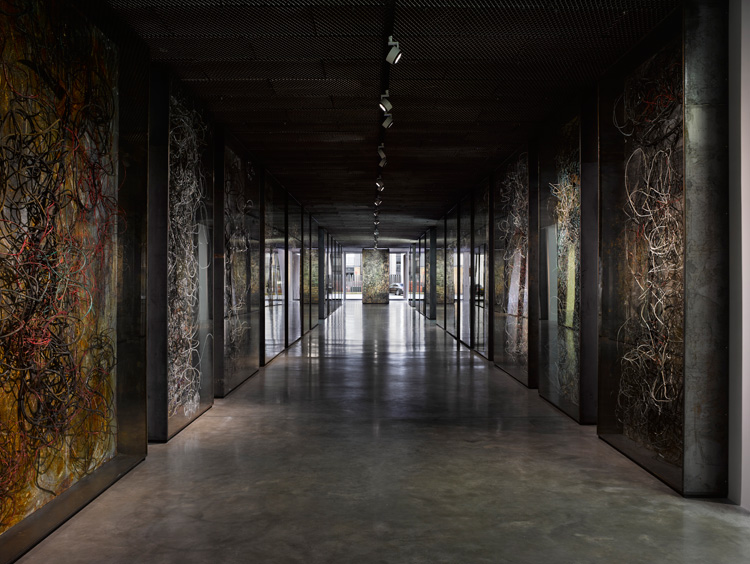
Anselm Kiefer, Superstrings, Runes, The Norns, Gordian Knot, White Cube Bermondsey 15 November 2019 - 26 January 2020 © Anselm Kiefer. Photo © White Cube (Ollie Hammick). Courtesy White Cube.
The effect of this installation, towering above visitors, narrowing the corridor and continuing for its entire length, is to overpower. Its mere presence almost entirely covers the normally white walls and darkens the available space. This darkness induces a sense of trepidation, a deep anxiety concerning what we might see next. Visitors are quiet in this corridor, a quietness that gives way to silent contemplation when the adjoining galleries are entered. There is a sense of awe, disbelief and confusion as we try to make sense of the truly gargantuan canvases we are faced with. In South Gallery I, three canvases more than 7 metres long and almost 3 metres high bear down on visitors who seem to alternate between two positions. First, visitors gravitate to the centre of the floor space, craning their necks upwards and slowly turning around 360 degrees in an attempt to take in what confronts them. Then, they are drawn to close looking and an examination of the strange and wonderful surfaces before them. There is paint in the form of emulsion, oil and acrylic, but there is also shellac, wood, straw and gold leaf. The encrusted surfaces of these charred landscapes suggest almost total destruction of the sweeping vistas before us. At the same time, the remnants of a once living landscape in the form of branches, twigs and straw gestures towards possible regrowth or regeneration.
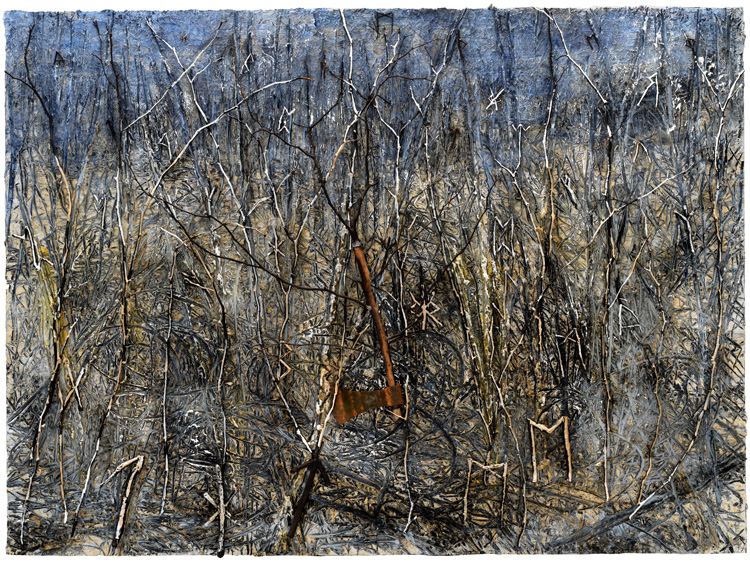
Anselm Kiefer, Der Gordische Knoten, 2019. Oil, emulsion, acrylic, shellac, wood and metal on canvas, 280 x 380 cm (110 1/4 x 149 5/8 in). © Anselm Kiefer. Photo © Georges Poncet, Courtesy White Cube.
In the North Galleries, five paintings on a slightly smaller scale, although still almost 4 metres wide, all address the theme of the Gordian knot. Indeed, four of the five paintings are titled Der Gordische Knoten (2019). Kiefer’s interest here is with the legend of Phrygian Gordium and the attempt to undo the tangled Gordian knot. Each painting, although different, deals with the same question in a similar fashion. A dense and wild tangle of dark branches, wheat and other plant matter is set against a background that appears filled with natural light. In the centre of the image, an axe, complete with rusty head and wooden handle, is entangled in the undergrowth. This is a reference to Alexander the Great and his solution to untangling the complex Gordian knot with one simple cut. It is also a metaphor for finding simple solutions to complex problems by exceeding the normal parameters for consideration.
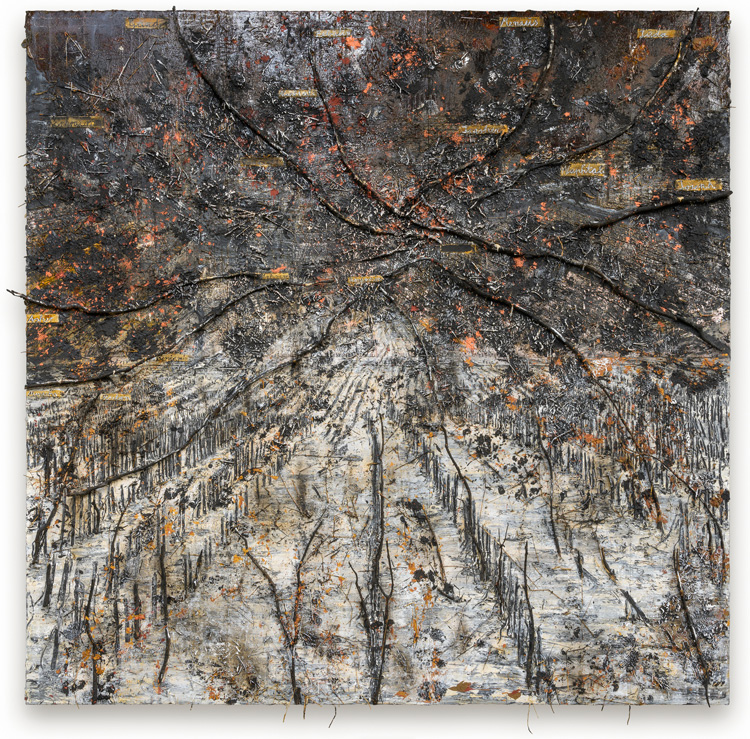
Anselm Kiefer, Ramanujan Summation - 1/12, 2019. Emulsion, oil, acrylic, shellac and wood on canvas, 660 x 665 cm (259 13/16 x 261 13/16 in). © Anselm Kiefer. Photo © Charles Duprat, Courtesy White Cube.
Gallery 9 x 9 x 9 houses a single painting Ramanujan Summation – 1/12 (2019). An ashen landscape is lined with row upon row of bare twig-like trees. Above the ground, a heavy sky is filled with stars and astrological signs. The painting’s title is taken from the name of a mathematical method or proof used to sum an infinite series of numbers. Once again, Kiefer’s interest is to bring divergent fields of inquiry together – the mystical and the scientific, the astronomic and the earthly, the historical and the contemporary.
The paintings shown in South Gallery II are landscapes, too, but now they are landscapes obscured by one structure or another and, of course, the structure itself is significant. The first work we encounter is The Veneziano Amplitude (2019), which takes it name from the discovery made by Gabriele Veneziano and the birth of string theory in 1968. A net of gridded lines extends across the painting’s surface and dominates the image. We are torn between looking at the net in its entirety and the individual units that make it up.

Anselm Kiefer, The Veneziano Amplitude, 2019. Oil, emulsion, acrylic, shellac and wood on canvas, 470 x 760 cm (185 1/16 x 299 3/16 in). © Anselm Kiefer. Courtesy White Cube.
At the other end of the gallery, Die Lebenden und die Toten (The Living and the Dead) (2019) shows an amphitheatre or parliament set in a desolate landscape. Redolent of the panopticon, the power structures at play here appear under threat from a mass of tumbling blackened straw. On the adjacent wall Die Sieben Siegel, die geheime Offenbarung des Johannes (The Seven Seals: The Secret Revelation of John) (2019) is especially chilling in its inclusion of burnt books jutting out of the canvas and towards the viewer. The reference to Nazi book-burning is unmistakable.
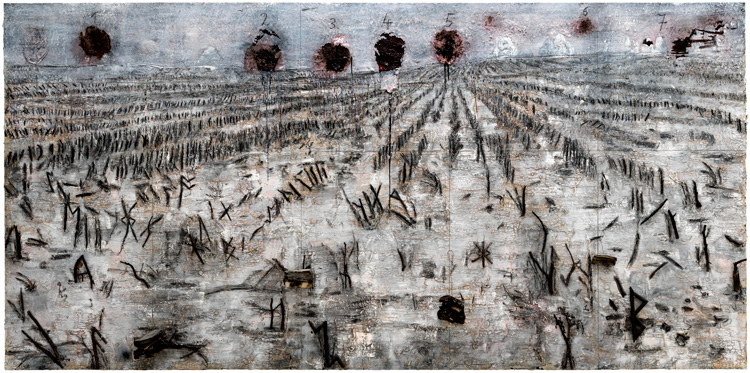
Anselm Kiefer, Die Sieben Siegel, die geheime Offenbarung des Johannes, 2019. Oil, emulsion, acrylic, shellac, wood and burnt books on canvas, 470 x 950 cm (185 1/16 x 374 in). © Anselm Kiefer. Photo © Georges Poncet, Courtesy White Cube.
Leaving this exhibition is difficult and its affect is profound. Walking the length of the corridor installation towards the exit only acts to reinforce that. Superstrings, Rune, The Norns, Gordian Knot (2019) is dark and tangled, messy and oppressive. Like the rest of the exhibition it is mysterious and unsettling, it is beyond nature and beyond intellectual grasp. This is the 21st century sublime.